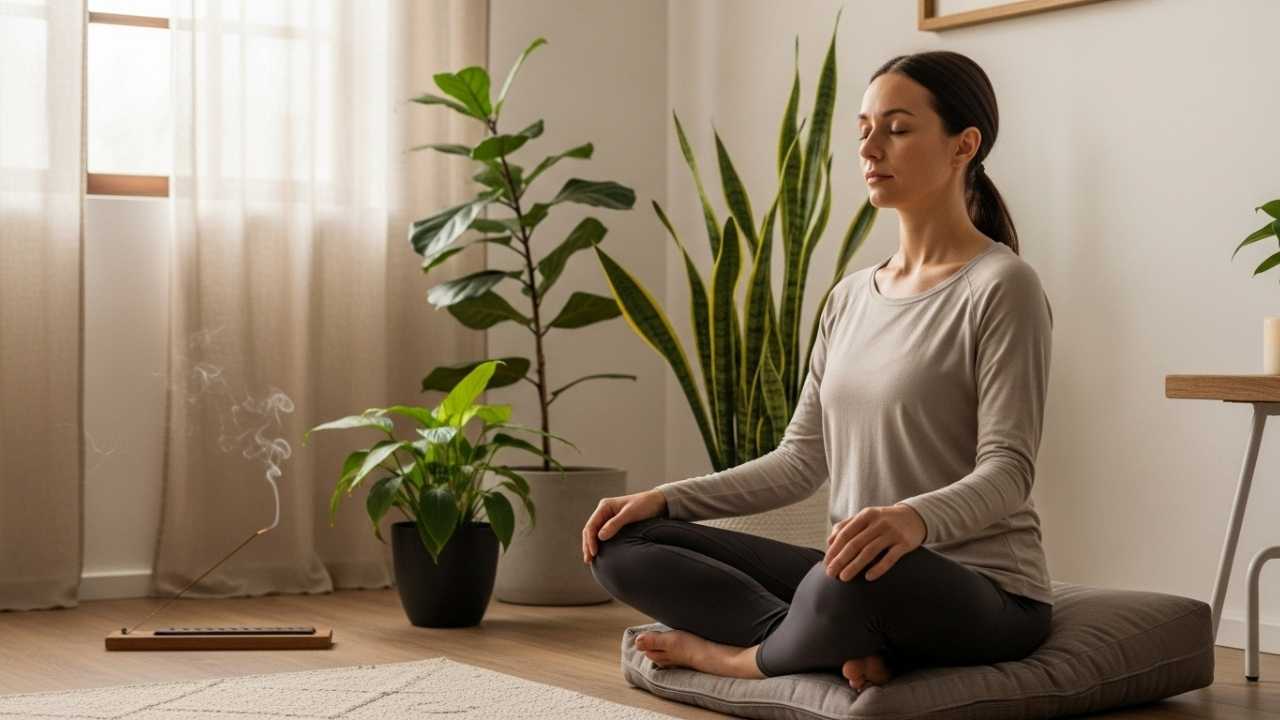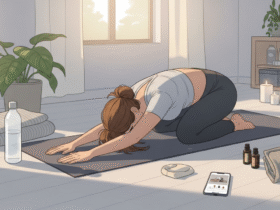If you’ve ever tried to meditate, only to find your mind racing with thoughts like what you’ll have for dinner, what went wrong in a meeting, or something you said back in 2016, you’re not alone. Meditation isn’t about completely clearing your mind, but about learning to focus and be present. For those new to the practice, it starts with the simple willingness to give it a try.
If you’re looking for a way to tame a busy mind, become more focused, or simply be more present in your daily life, this guide is for you. We’ll break down what meditation really is, why it’s worth your time, and how you can begin practicing right now—without needing incense, a yoga mat, or a guru.
What is Meditation? (A Beginner’s Perspective)
In its simplest form, meditation is all about returning to the present moment. It’s not about shutting off your thoughts or achieving perfect calm. Instead, it’s about observing your thoughts, emotions, and surroundings without judgment.
You might imagine meditation as monks sitting in silence for hours, but the truth is, meditation can be as simple as five minutes of focused breathing while waiting for your coffee to brew. It’s a tool that’s flexible and adaptable—it doesn’t have to fit into one rigid mold.
Meditation isn’t about escaping life. Instead, it’s about finding clarity and calm while engaging with life. The goal is to become more aware of the present moment, cultivating peace in the midst of daily activity.
Why Should You Begin Meditating? (Science and Soul Reasons)
Whether it’s being studied in a lab or practiced during a spiritual retreat, meditation has earned its place as a powerful tool for overall well-being. But you don’t have to be in crisis mode to benefit from it. In fact, just a few minutes a day can create lasting positive changes in your life.
Here are some scientifically backed benefits of routine meditation:
Benefits of Meditation for Beginners
| Benefit | Description |
|---|---|
| Reduced Stress | Meditation lowers cortisol (the stress hormone), creating a sense of calm. |
| Better Sleep | Helps quiet the mind, reducing nighttime anxiety and improving sleep quality. |
| Improved Focus | Builds your brain’s ability to concentrate and ignore distractions. |
| Emotional Resilience | Supports mood regulation and reduces emotional reactivity. |
| Self-Awareness | Encourages reflection and healthier responses in daily situations. |
Those who make meditation a habit often describe it as having an “on-off stop button” — a tool that helps them reset emotionally and mentally in the middle of life’s chaos. Once you experience that inner peace, it’s something you’ll want to return to again and again.
5 Simple Meditation Techniques You Can Try Today

You don’t have to sit cross-legged on a mountaintop or speak Sanskrit to enjoy the benefits of meditation. What you truly need is curiosity, patience, and a willingness to try. Here are five simple meditation methods that beginners can adopt right now—no experience required!
1. Breath Awareness Meditation
This is one of the easiest methods to get started. All it involves is focusing on your natural breath.
How to Do It:
- Sit in a chair or on the ground in a comfortable position.
- Close your eyes (or keep them lightly blurred).
- Focus your attention on the sensation of the air entering and leaving your nose or chest.
- When your mind drifts (which it will), gently bring your focus back to your breath.
Why It Works:
You always have your breath with you. This helps quiet the mind and re-establish a sense of calm.
2. Body Scan Meditation
This technique helps you connect with your body and release tension, often in areas you weren’t even aware were tight.
How to Do It:
- Lie down or sit in a comfortable position.
- Start by focusing on your toes.
- Slowly move your attention up through your body, from your feet, legs, hips, stomach, chest, shoulders, arms, neck, to your head.
- Notice any sensations like tingling, warmth, tightness—just observe without judgment.
Why It Works:
It helps raise awareness of physical tension, allowing your body to release and relax.
3. Mindful Observation
This meditation focuses all of your attention on one object or natural element, allowing you to be present and engaged.
How to Do It:
- Choose something simple—like a candle flame, a leaf, or a cup of tea.
- Observe it carefully: its color, shape, movement, and texture.
- If your mind wanders, gently bring it back to the object you’re observing.
Why It Works:
This practice teaches you mindfulness and helps you appreciate the beauty around you, even in ordinary things.
4. Mantra Meditation
A mantra is a word, sound, or phrase that you repeat to yourself, either silently or aloud, to center your attention and quiet the mind.
How to Do It:
- Sit down comfortably and take a few deep breaths.
- Choose a soothing word or phrase, such as “peace,” “still,” or “sohum” (pronounced so-hum).
- Repeat the mantra in sync with your breathing.
- Allow the repetition to calm and relax your nervous system.
Why It Works:
Repetition helps focus the mind, making it especially useful when you feel overwhelmed by busy thoughts.
5. Walking Meditation
Walking meditation is ideal for individuals who cannot or prefer not to sit still. It’s a dynamic way to meditate while still gaining the benefits of mindfulness and presence.
How to Do It:
- Whether indoors or outdoors, find a path that allows you to walk slowly and calmly.
- Focus on the sensation of your feet touching the ground as you walk.
- Move at a pace that feels comfortable, but keep your attention on each step.
- Pay attention to your surroundings—sounds, sights, and feelings as you walk.
Why It Works:
Walking meditation helps center your mind, body, and surroundings, especially when you’re feeling restless or anxious. The physical movement combined with mindfulness helps anchor you in the present moment.
How to Set Up Your First Meditation Space
You don’t need an expensive pillow or a soundproof chamber to meditate. The most important element of your meditation space is that it’s quiet, comfortable, and free from distractions.
How to Set Up Your Meditation Space:
- Choose a Quiet Spot: It could be beside a window, in a cozy corner, or even your bed.
- Comfort is Key: Sit on a cushion or folded blanket to ensure your hips are slightly above your knees for comfort.
- Personal Touches: Consider adding a candle, essential oil diffuser, soft lighting, or soothing background music—whatever makes you feel relaxed.
Some people prefer complete silence, while others like gentle background music. Experiment to see what works best for you.
Beginner Meditation Tips to Make It Stick
Let’s face it: starting any new habit isn’t easy, and meditation is no exception. The key to success isn’t about long, perfect sessions—it’s about consistency. Small, regular practice will lead to better results over time.
Here are some tips to help you stick with it:
🕒 1. Start Small
Even two minutes a day is enough to get started. It’s better to meditate briefly every day than to start with long sessions and risk burning out. Consistency is what counts.
🔁 2. Turn It Into a Habit
Pair your meditation with another activity you already do regularly, such as brushing your teeth or making your morning coffee. By associating meditation with an existing habit, it becomes part of your daily routine.
📱 3. Use Guided Meditations
Apps like Insight Timer, Headspace, and Calm offer free guided meditations. Having a gentle voice guide you through the process can be especially helpful when you’re just starting out.
🤯 4. Expect Your Mind to Wander
It’s completely normal for your mind to wander during meditation. Remember, the goal isn’t to stop your thoughts but to notice when they arise and gently bring your focus back to your breath or meditation practice.
🧘 5. Be Kind to Yourself
Some days you’ll feel calm and centered; other days you may feel distracted or frustrated. That’s perfectly okay. Every time you show up for your practice, you’re improving your ability to be present.
Common Struggles Beginners Face (And Gentle Solutions)
Meditation can be frustrating, especially when you’re starting. Sitting still doesn’t automatically quiet your mind, and this is why many beginners give up before they experience the benefits. The truth is, meditation isn’t about stopping your thoughts—it’s about changing your relationship with them.
Here are some of the most common struggles and ways to overcome them:
| Struggle | Mindful Solution |
|---|---|
| “My mind won’t stop thinking.” | Minds are designed to think. Meditation helps you notice, not erase, thoughts. Return gently to the breath. |
| “I fall asleep during meditation.” | Try meditating in an upright position or earlier in the day when you’re more alert. |
| “I feel silly or awkward.” | You’re learning something new. The discomfort is temporary. Allow it without judgment. |
| “I forget to do it daily.” | Attach meditation to an existing habit, like brushing your teeth or morning coffee. |
Building a Consistent Practice (Without Pressure)
In today’s fast-paced world, we often want immediate change. However, meditation teaches us to believe in the gradual process. Consistency doesn’t mean meditating for 30 minutes every day; rather, it means showing up regularly, even if it’s for less than five minutes.
Here’s how to maintain your practice:
Track Your Progress: Over time, you’ll begin to notice changes, such as calmer mornings, more patience, or better sleep.
Set a Routine Time: Choose a time that aligns with your energy levels and schedule.
Make it Easy to Remember: Use reminders like a note on the mirror, an app notification, or a bell to signal your meditation time.
Pardon Lapses: Life happens. If you miss a day, don’t worry—just recommence without guilt.
Reflect After Each Session: Take a moment to reflect on how you feel after each practice and consider writing it down.
Tools That Can Help You Along the Way
As a beginner, having the right resources can make the process feel more accessible and enjoyable. These tools can simplify your meditation practice:
Free Meditation Apps:
- Insight Timer: A vast library of free meditations tailored to different moods and times of day.
- Headspace: Great for structured courses that guide beginners through the basics.
- Calm: Soothing music and guided meditation for relaxation.
- Smiling Mind: A meditation app suitable for all ages, including children and teenagers.
Suggested Books:
- Wherever You Go, There You Are by Jon Kabat-Zinn
- The Miracle of Mindfulness by Thich Nhat Hanh
- Radical Acceptance by Tara Brach
Nature Sounds and Music:
Search for “Lo-fi focus tracks,” “Rainforest noise,” or “432 Hz healing frequencies” on YouTube or Spotify to create a calming background for your meditation.
Breathing Techniques:
- Box Breathing: Inhale for 4 counts, hold for 4, exhale for 4, hold for 4.
- 4-7-8 Breathing: Inhale for 4 counts, hold for 7, exhale for 8. This is great for relaxation and sleep.
- Belly Breathing: Place your hand on your stomach and focus on the rise and fall of your belly as you breathe.
What Happens After a Few Weeks of Meditating
When you commit to small, daily doses of meditation, you’ll begin to notice subtle shifts in how you respond to life—not necessarily making life easier, but making your reactions more mindful and intentional. Over time, you’ll experience:
- Pausing before you respond: Meditation helps you hesitate and choose your reactions more thoughtfully.
- Better sleep: Consistent practice leads to deeper, more restful sleep.
- Mindful breathing: You’ll naturally begin to breathe more deeply without thinking about it.
- Less emotional hijacking: You’ll become more resilient to emotional stress and reactivity.
This process of neuroplasticity—the brain’s ability to rewire itself—is what leads to calmness and clarity. It’s built upon repeated acts of kindness, both to yourself and others.
Meditation in Real Life (Not Just on the Cushion)
Meditation isn’t just something you sit down and do for a few minutes—it gradually begins to seep into every aspect of your life, making you better at relating to the world around you. Meditation becomes a way of life, affecting your interactions, decisions, and overall well-being.
Ways Meditation Becomes Part of Your Everyday Life
Here are some simple ways meditation integrates into your daily routine, turning mindfulness into a natural habit:
Mindful Eating
- Go slow with your first few bites.
- Focus on the taste, texture, and temperature of your food.
- Chew thoroughly and savor each bite, paying full attention to the eating experience.
Mindful Walking
- Leave your phone behind and go for a walk.
- Pay attention to the sound of your footsteps, the wind, and the rhythm of your breath as you walk.
- Focus entirely on the act of walking without distraction.
Mindful Moments
- Throughout your day, take small breaks to focus on your breath.
- Before a meeting, opening your inbox, or when feeling overwhelmed, take three deep breaths.
- These moments of silence are also forms of meditation, helping you reset and regain focus.
Meditation Doesn’t Mean an Empty Mind—It’s About Smooth Focus
Many newcomers believe they’re doing meditation “wrong” because their minds don’t immediately quiet down. But remember:
- Not focusing doesn’t mean you’re failing.
- Every time you notice your mind wandering and gently bring your focus back, you are strengthening your inner awareness.
Meditation is that return—the small shift in focus that happens every time your mind drifts.
No one wins a prize for having the quietest mind. The true reward is the ability to remain present with yourself, even when the moment is uncomfortable.
7-Minute Starter Meditation Script
If you’re new to meditation, this simple 7-minute script can guide you through a short, focused practice. All you need is a timer, a quiet space, and a few minutes.
0-2 Minutes: Grounding and Breath
- Sit comfortably with your back straight and relaxed.
- Close your eyes or let them rest softly.
- Place your feet on the ground.
- Take a few deep breaths: inhale through your nose, exhale through your mouth.
2-4 Minutes: Body Awareness
- Gently scan your body, starting at your head and moving down to your toes.
- Notice any areas of tension or tightness, or areas of ease.
- There’s no need to change anything—just observe.
4-6 Minutes: Easy Mantra
- Choose a quiet phrase to repeat with each breath, such as “I am” (breathe in) and “calm” (breathe out).
- When your thoughts wander, gently return to the mantra, bringing your focus back to your breathing.
6-7 Minutes: Gratitude and Finalization
- Think of something you’re thankful for at this moment.
- Smile softly, feeling gratitude.
- Slowly prepare to open your eyes and come back to the present moment.
That’s it! You’ve meditated. Each time you practice, it will feel a little more natural.
Summary: Meditation Is About Presence, Not Perfection
You don’t need to drastically change your lifestyle, spend money on fancy tools, or completely transform yourself. All it takes is a few minutes each day to stop and come home to yourself.
Meditation isn’t about removing stress; it’s about altering the way you carry stress. Over time, you’ll find your thoughts becoming more focused and deliberate, leading to a more peaceful, serene life.
Stop trying to be perfect. Choose presence instead.















Leave a Reply